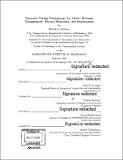| dc.contributor.advisor | Peter P. Belobaba. | en_US |
| dc.contributor.author | Wittman, Michael D.(Michael David) | en_US |
| dc.contributor.other | Massachusetts Institute of Technology. Department of Aeronautics and Astronautics. | en_US |
| dc.date.accessioned | 2019-11-04T20:20:17Z | |
| dc.date.available | 2019-11-04T20:20:17Z | |
| dc.date.copyright | 2018 | en_US |
| dc.date.issued | 2018 | en_US |
| dc.identifier.uri | https://hdl.handle.net/1721.1/122707 | |
| dc.description | Thesis: Ph. D., Massachusetts Institute of Technology, Department of Aeronautics and Astronautics, 2018 | en_US |
| dc.description | Cataloged from PDF version of thesis. | en_US |
| dc.description | Includes bibliographical references (pages 223-228). | en_US |
| dc.description.abstract | Even as the distribution and sale of commercial airline tickets has shifted in recent years from physical reservation offices to the Internet, many airline commercial processes remain highly reliant on pre-Internet technologies and standards. This legacy infrastructure compels airlines to publish a discrete set of prices in each market they serve, and to select prices for each itinerary from among only this limited set of possible price points. Recent advancements in distribution technology, such as the New Distribution Capability (NDC), offer airlines the chance to break away from these constraints. These new standards enable the creation of customized offers with prices that could be generated dynamically in real time. While airlines have shown interest in these new technologies, practical methods for integrating dynamic pricing into existing airline revenue management (RM) and distribution systems have yet to be defined and evaluated by academics or practitioners. | en_US |
| dc.description.abstract | In this work, we propose the first mechanisms for dynamic pricing designed specifically for use in the airline industry. By selectively providing increments or discounts based on demand segmentation and estimates of willingness-to-pay (WTP), our mechanisms can increase airline revenues by stimulating new bookings from price-sensitive travelers while encouraging more price-inelastic travelers to buy up to higher price points. Moreover, the methods are compatible with the pricing, RM, and distribution systems currently used by airlines today. Our dynamic pricing heuristics emerge from the development of a novel theoretical model of customer choice. Using the model, we introduce a new concept called "conditional WTP" to describe how a customer's willingness-to-pay for an itinerary can change depending on the other alternatives available in his choice set. | en_US |
| dc.description.abstract | We show how assuming an unchanging maximum WTP for air travel, as in past work on dynamic pricing, can lead to overestimation of WTP in competitive environments, and describe how an airline's estimates of conditional WTP play an integral role in our dynamic pricing mechanisms. We test our dynamic pricing methods in the Passenger Origin-Destination Simulator (PODS): a robust agent-based booking simulation that models the interactions between passengers and airlines. In a complex, competitive network, we find that our heuristics can increase airline revenues by up to 1 - 4% from traditional pricing and RM alone. Incrementing prices can result in revenue gains through an increase in yield, and discounting can lead to higher revenues through demand stimulation and share shift from other airlines. In both cases, we identify a phenomenon we call "forecast spiral-up" which increases yield by protecting more seats for higher-value fare classes. | en_US |
| dc.description.abstract | We also develop a variant of the heuristic in which multiple substitutable flights are priced simultaneously, leading to additional revenue gains. Finally, we provide the first in-depth assessment of the practical implications of dynamic pricing for the airline industry. We focus on airline concerns that dynamic pricing could lead to price wars, excessive discounting, and a race to the bottom. We also evaluate some of the potential legal implications and customer reactions that could emerge as dynamic pricing becomes more commonplace. These analyses provide new insight on how airline competition could potentially change as dynamic pricing is integrated into traditional airline processes. | en_US |
| dc.description.statementofresponsibility | by Michael D. Wittman. | en_US |
| dc.format.extent | 228 pages | en_US |
| dc.language.iso | eng | en_US |
| dc.publisher | Massachusetts Institute of Technology | en_US |
| dc.rights | MIT theses are protected by copyright. They may be viewed, downloaded, or printed from this source but further reproduction or distribution in any format is prohibited without written permission. | en_US |
| dc.rights.uri | http://dspace.mit.edu/handle/1721.1/7582 | en_US |
| dc.subject | Aeronautics and Astronautics. | en_US |
| dc.title | Dynamic pricing mechanisms for airline revenue management : theory, heuristics, and implications | en_US |
| dc.type | Thesis | en_US |
| dc.description.degree | Ph. D. | en_US |
| dc.contributor.department | Massachusetts Institute of Technology. Department of Aeronautics and Astronautics | en_US |
| dc.identifier.oclc | 1123216988 | en_US |
| dc.description.collection | Ph.D. Massachusetts Institute of Technology, Department of Aeronautics and Astronautics | en_US |
| dspace.imported | 2019-11-04T20:20:16Z | en_US |
| mit.thesis.degree | Doctoral | en_US |
| mit.thesis.department | Aero | en_US |
